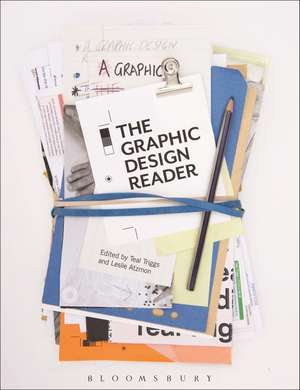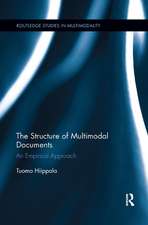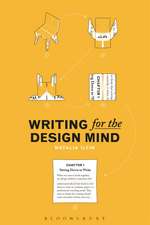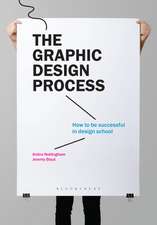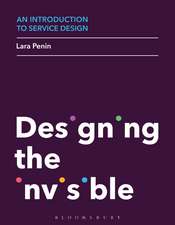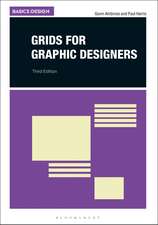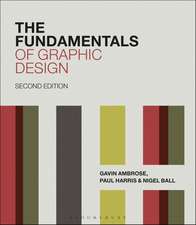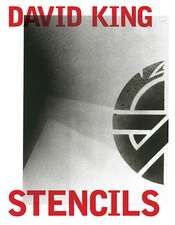The Graphic Design Reader
Editat de Teal Triggs, Leslie Atzmonen Limba Engleză Paperback – 20 feb 2019
| Toate formatele și edițiile | Preț | Express |
|---|---|---|
| Paperback (1) | 306.02 lei 22-36 zile | +145.42 lei 6-12 zile |
| Bloomsbury Publishing – 20 feb 2019 | 306.02 lei 22-36 zile | +145.42 lei 6-12 zile |
| Hardback (1) | 922.52 lei 22-36 zile | |
| Bloomsbury Publishing – 20 feb 2019 | 922.52 lei 22-36 zile |
Preț: 306.02 lei
Preț vechi: 353.58 lei
-13% Nou
Puncte Express: 459
Preț estimativ în valută:
58.58€ • 63.65$ • 49.24£
58.58€ • 63.65$ • 49.24£
Carte disponibilă
Livrare economică 31 martie-14 aprilie
Livrare express 15-21 martie pentru 155.41 lei
Preluare comenzi: 021 569.72.76
Specificații
ISBN-13: 9781472526472
ISBN-10: 1472526473
Pagini: 1000
Ilustrații: 360 bw illus
Dimensiuni: 189 x 246 x 42 mm
Greutate: 2.11 kg
Editura: Bloomsbury Publishing
Colecția Bloomsbury Visual Arts
Locul publicării:London, United Kingdom
ISBN-10: 1472526473
Pagini: 1000
Ilustrații: 360 bw illus
Dimensiuni: 189 x 246 x 42 mm
Greutate: 2.11 kg
Editura: Bloomsbury Publishing
Colecția Bloomsbury Visual Arts
Locul publicării:London, United Kingdom
Caracteristici
Includes extracts from classic and foundational writings in the field, alongside specially-commissioned visual essays by leading practitioners
Notă biografică
Teal Triggs is Professor of Graphic Design and Associate Dean, School of Communication, Royal College of Art, UK.Leslie Atzmon is Professor of Graphic Design and Design History at Eastern Michigan University, USA.
Cuprins
Introduction: The Graphic Design Reader SECTION I - HISTORY OF GRAPHIC DESIGN and GRAPHIC DESIGN HISTORY IntroductionIndustry and the Birth of Graphic Design (19th Century to 1980) 1. New Kind of Printing Calls for New Design, W.A. Dwiggins 2. Note by William Morris on His Aims in Founding the Kelmscott Press, William Morris 3. The Studio: Photomechanical Reproduction and the Changing Status of Design, Gerry Beegan 4. Narrative Problems of Graphic Design History, Victor Margolin 5. Elementary School, J. Abbott Miller 6. Graphic Design History by Steven Heller; Georgette Ballance; Texts on Type: Critical Writings on Typography edited by Steven Heller; Philip B. Meggs, Michael Golec? Graphic Design Canon(s) (1980s to present) 7. Cult of the Ugly, Steven Heller 8. An Interview with Edward Fella, Michael Dooley 9. An Unbearable Lightness? Steven Rigley 10. Is There a Canon of Graphic Design History? Martha Scotford 11. Good History Bad History, Tibor Kalman, J. Abbott Miller and Karrie Jacobs 12. Out of the Studio: Graphic Design History and Visual Studies, Rick Poynor Isms and Graphic Design 13. The Grid: History, Use, and Meaning, Jack Williamson 14. Gebrauchsgraphik as an Early Graphic Design Journal, 1924-1938, Jeremy Aynsley15. Zombie Modernism, Mr. Keedy 16. The Global Style: Modernist Typography After Postmodernism, Jeffrey Keedy17. The Bottom Line on Planet One: Squaring up to The Face, Dick Hebdige 18. A Brave New World: Understanding Deconstruction, Chuck Byrne and Martha Witte Guide to Further Reading SECTION II: EDUCATION AND THE PROFESSIONIntroductionII.1 Graphic Design Education1. Education and Professionalism or What's wrong with graphic design education? Katherine McCoy 2. England: The Working Party on Typographic Teaching, Michael Twyman 3. A Journey Toward Sublime, Damian and Laura Santamaria4. Scaffolding a Human-centred Practice in Graphic Design, Yoko Akama 5. VISUAL ESSAY: Future Issue: A Subjective Family Tree of (mostly) American Graphic Designers (1960-2011), Michael Worthington and Yasmin Khan II.2 Post-Graduate Education and Graphic Design as a Profession 6. Design Literacy, Discourse and Communities of Practice, Sharon Helmer Poggenpohl 7. What is Worth Doing in Design Research?, Meredith Davis 8. Locating Graphic Design History in Canada, Brian Donnelly 9. French Graphic Design: A Contradiction in Terms? Véronique Vienne 10. The Importance of the Dutch Football Club Ajax and Total Football (totaalvoetbal) to the Sport of Graphic Design, Elliott Earls 11. Graphic Design: Fine Art or Social Science? Jorge Frascara Guide to Further Reading SECTION III: TYPE AND TYPOGRAPHYIntroductionIII.1 History of Type and Typography 1. A Brief History of Type Historians, Caroline Archer 2. The Crystal Goblet, or Printing Should be Invisible Beatrice Warde 3. Fuse 1-20: Wreckers of Typographic Civilisation, Adrian Shaughnessy 3. Experimental typography. Whatever that means; Conceptual Type? Peter Bil'ak 4. Towards the Cause of Grunge, Tobias Frere-Jones 5. About the Making of The Telephone Book, Michael Jon Jensen 6. Helvetica, The Film and the Face in Context, Dietmar R. Winkler III.2 Dimensional, Physical, Digital, and Kinetic Typography 8. Dimensional Typography: Case Studies on The Shape of Letters in Virtual Environments J. Abbott Miller 9. Dimensional Typography: The Unbearable Flatness of Being, Leslie Atzmon10. The New Seduction: Moveable Type, Michael Worthington 11. Electronic Typography: The New Visual Language, Jessica Helfand 12. Working the Art Process by Typing in Computer Code, Casey Reas and Ben Fry in discussion with Javier Candeira Guide to Further Reading SECTION IV: GRAPHIC DESIGN CRITICAL WRITING AND PRACTICE Introduction IV.1 Graphic Design Theory and Design Culture 1. Deconstruction and Graphic Design, Ellen Lupton and J. Abbott Miller 2. Visual Rhetoric and Semiotics, Edward Triggs 3. Shaping Belief: The Role of Audience in Visual Communication, Ann C. Tyler 4. Graphic Design as Rhetoric: Towards a New Framework for Theory and Practice in Graphic Design, Arne Scheuermann 5. Theories to Understand Graphic Design in Use: The Example of Posters, Jan-Henning Raff IV.2 Writing, Practice, and Graphic Design Criticism6. What is this Thing Called Graphic Design criticism I & II? Rick Poynor and Michael Rock 7. Criticism and the Politics of Absence, Anne Bush 8. Quietude, Kenneth FitzGerald 9. Critical Graphic Design: Critical of What? Francisco Laranjo10. The March of Grimes, Michèle Champagne 11. Discourse This! Designers and Alternative Critical Writing, Denise Gonzales Crisp 12. Acrobat Reader, Anna Gerber and Teal Triggs 13. How and Why Design Matters, Debbie Millman 14. Inquiry as a Verb: DesignInquiry, Margo Halverson 15. Graphic Design in the Collection of the Museum of Modern Art, Paola Antonelli Guide to Further Reading SECTION V: POLITICAL & SOCIAL CHANGE Introduction V.1 Feminism and Radical Graphic Design1. Some Aspects of Design from the Perspective of a Woman Designer, Sheila Levrant de Bretteville 2. Non-existent Design: Women and the Creation of Type, Sibylle Hagmann 3. Pussy Galore Buddah of the Future: Women, Graphics, etc., Catherine de Smet 4.VISUAL ESSAYS:First Things First manifesto,1964, Ken Garland and First Things First 2000 manifesto (1999), Ken Garland, Adbusters5. VISUAL ESSAY: This Year There is No Manifesto, Jonathan Barnbrook and Anil Aykan 6 Design and Reflexivity, Jan van Toorn 7. Scissors and Glue: Punk Fanzines and the Creation of a DIY Aesthetic, Teal Triggs 8. He Might Be Giant: Shepard Fairey, Michael Dooley V.2 Identity and World Graphic Design 9. From the Outside In: A Place for Indigenous Graphic Traditions in Contemporary South African Graphic Design, Piers Carey 10. Searching for a Black Aesthetic in American Graphic Design, Sylvia Harris 11. Finding Roots & Taking Flight: Expression of Identity in Contemporary Graphic Design in India, Mohor Ray 12. Visualizing Multi-Racialism in Singapore: Graphic Design as a Tool for Ideology and Policy in Nation Building, Leong K. Chan 13. VISUAL ESSAY: 'Iced Up' and 'Platinum Plus': The Development of Hip-Hop Typographic Ornaments, Ryan Molloy 14. South African Health Campaigns Dominate the Political Landscape, Sean O'Toole 15. Detachment and Unification: A Chinese Graphic Design History in Greater China Since 1979, Wendy Siuyi Wong Guide to Further Reading SECTION VI: CHANGING VISUAL LANDSCAPES Sectional Introduction VI.1 Branding and the Image Makers 1.My Country is Not A Brand, William Drenttel 2. Logos, Flags, and Escutcheons, Paul Rand3. A Certain Commitment: Art and Design at the Royal PTT, Paul H. Hefting4. On Logophobia, Elizabeth Glickfeld 5. How the First Typeface Designed for the Maori Community is Changing the Way New Zealand Understands its Own Cultural Identity, Margaret Andersen VI.2 Information Visualisation 6. VISUAL ESSAY: Design Quarterly: Does it make sense? April Greiman and Making Sense of Making Sense, Louise Sandhaus 7. Why Abraham Lincoln Loved Infographics, Gareth Cook 8. The London Underground Diagram: A Semiotic Analysis, John A. Walker 9. Bubbles, Lines, and String: How Information Visualization Shapes Society, Peter Hall 10. Tell Them Anything but the Truth: They Will Find Their Own. How We Visualized the Map of the Future with Respect to the Audience of Our Story, Michele Graffieti, Gaia Scagnetti, Donato Ricci, Luca Masud, and Mario Porpora 11. Data Manifestation: A Case Study, Karin von Ompteda Guide to Further Reading SECTION VII: GRAPHIC DESIGN FUTURES Sectional Introduction VII.1 The Future of Print Media/the Book 1. What is the Cult Future of the Book, Johanna Drucker 2. The Signifier of Incompleteness: Editorial illustration in the New Media Age, Nanette Hoogslag 3. Rethinking the Book: Navigation and Wayfinding, David Small 4. Writing Design: Towards a Culture of Code, Stéphanie Vilayphiou and Alexandre Leray VII.2 The Forefront of Graphic Design Practice5. Social Design: The Context of Post-Conflict Lebanon, Joanna Choukeir6. Emil Ruder: A Future for Design Principles in Screen Typography, Hilary Kenna 7. Everything to Come is Designed by You. Tea Uglow 8. VISUAL ESSAY: RCA Graphic Design: 1960s-2010s, Rosy Penston Epilogue: Adaptive Communication, Complex Networks, and Local and Global DesignNotes from the Forefront of Graphic Design, Teal Triggs and Leslie Atzmon Annotated Guide to Further Reading
Recenzii
The Graphic Design Reader is a highly useful resource that will give wider exposure to a wealth of significant andinsightful writing on graphic design, much of it new or not widely anthologized
The Graphic Design Reader is the most inclusive collection of graphic design writing to date . Summing Up: Highly recommended. Upper-division undergraduates; graduate students; professionals."
This scholarly and engaging collection of key readings provides an excellent body of work for those who wish to understand how the subject of graphic design is moving from a field towards a discipline.
A vital intervention in critical writing, design theory and design practice ... [Which is] brilliantly organised ... A detailed and intellectually comprehensive introduction gives both necessary context and contemporary insights.
[Gives] serious attention to design writing ... This hefty tome should find a home on the shelves of anyone interested in design writing.
Consolidating and expanding all key strands which satellite and enhance a field very close to my heart, this anthology allows readers to examine the interconnected scope of this remarkable field.
A well-organized, wide-ranging, and bountiful collection of graphic design's history, practices, and ideals. The Graphic Design Reader deserves space on any graphic design student or practitioner's shelf.
The Graphic Design Reader is one of the most exciting books I've seen published in the field of graphic design. It is more than a historical overview, more than a single viewpoint. This book contains the past and the future of graphic design practice. It not only gathers together a critical collection of key writings and visual essays - it has been curated expertly to provide a launching point for new futures in graphic design thought, education and practice. I have no hesitation in recommending this new publication to anyone involved in graphic design practice and education; designer, student or teacher.
The Graphic Design Reader is the most inclusive collection of graphic design writing to date . Summing Up: Highly recommended. Upper-division undergraduates; graduate students; professionals."
This scholarly and engaging collection of key readings provides an excellent body of work for those who wish to understand how the subject of graphic design is moving from a field towards a discipline.
A vital intervention in critical writing, design theory and design practice ... [Which is] brilliantly organised ... A detailed and intellectually comprehensive introduction gives both necessary context and contemporary insights.
[Gives] serious attention to design writing ... This hefty tome should find a home on the shelves of anyone interested in design writing.
Consolidating and expanding all key strands which satellite and enhance a field very close to my heart, this anthology allows readers to examine the interconnected scope of this remarkable field.
A well-organized, wide-ranging, and bountiful collection of graphic design's history, practices, and ideals. The Graphic Design Reader deserves space on any graphic design student or practitioner's shelf.
The Graphic Design Reader is one of the most exciting books I've seen published in the field of graphic design. It is more than a historical overview, more than a single viewpoint. This book contains the past and the future of graphic design practice. It not only gathers together a critical collection of key writings and visual essays - it has been curated expertly to provide a launching point for new futures in graphic design thought, education and practice. I have no hesitation in recommending this new publication to anyone involved in graphic design practice and education; designer, student or teacher.
